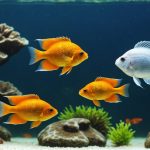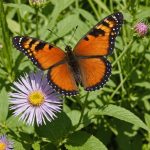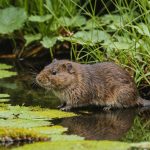British otters, enchanting yet elusive, thrive in habitats tailored to their needs. To boost their presence, we must focus on enhancing wetlands, riverbanks, and woodlands. This involves planting native vegetation, restoring natural water courses, and reducing pollution. By implementing these vital improvements, we can create environments where otters not only survive but flourish. Discover how these changes benefit not just otters, but entire ecosystems, fostering biodiversity and a healthier planet.
Understanding British Otters and Their Habitat Needs
Exploring the essentials of otter habitats in the UK.
A lire aussi : Essential Guide to Properly Quarantining New Fish for a Healthy Aquarium
Overview of British Otter Behavior and Ecology
British otters are fascinating creatures with unique behavioral patterns. They are primarily nocturnal, spending much of their time hunting and playing in the water. Otters are highly adaptable, but their survival hinges on specific habitat requirements. They need access to clean rivers, lakes, and coastal areas, which provide essential resources for their daily activities.
Key Habitat Components Essential for Otters
A suitable habitat for British otters includes several critical components:
Sujet a lire : Discovering Cutting-Edge Therapies for Chronic Kidney Disease in Senior Cats: A Guide to the Latest Treatments
- Water Quality: Pristine water is vital for otters, as it supports the fish and invertebrates they feed on.
- Food Sources: Abundant prey, such as fish and crustaceans, is crucial for sustenance.
- Shelter: Natural features like dense vegetation and fallen logs offer protection and breeding sites.
Importance of Water Quality and Food Sources
High water quality is indispensable for otters, ensuring a healthy ecosystem. Poor water conditions can deplete food sources, affecting otter populations. Conservation efforts focus on maintaining and improving these habitats, emphasizing the importance of water purity and availability of prey.
In summary, understanding the habitat needs of British otters is essential for their conservation, ensuring these charming animals continue to thrive across the UK.
Practical Tips for Enhancing Otter Habitats
Enhancing otter habitats requires thoughtful planning and execution.
Steps to Create and Maintain Suitable Water Bodies
Creating suitable water bodies is critical for otter habitat enhancement. Ensure water sources are clean and free from pollutants. Regularly monitor water quality to maintain a healthy ecosystem. Introducing native vegetation around water bodies helps stabilize banks and improve habitat quality.
Importance of Native Vegetation and Planting Strategies
Native vegetation plays a crucial role in otter habitat enhancement. Planting indigenous species supports local biodiversity and provides natural shelter. Consider these strategies:
- Select plants that thrive in your local climate.
- Space plantings to allow for growth and water access.
- Maintain vegetation to prevent overgrowth and ensure accessibility.
Techniques for Improving Riverbank Health and Stability
Healthy riverbanks are essential for otter habitats. To enhance stability:
- Use bioengineering techniques, such as live staking.
- Install coir logs to prevent erosion.
- Encourage root growth through strategic planting.
Implementing these practical tips can significantly improve otter habitats, ensuring these charming creatures continue to thrive. By focusing on key elements such as water bodies, native vegetation, and riverbank health, you can make informed decisions that benefit both otters and the wider ecosystem.
The Role of Native Vegetation
Understanding the significance of native vegetation is crucial for enhancing otter habitats.
Benefits of Native Plants
Native plants offer numerous benefits to otter habitats. They promote biodiversity, which is essential for a thriving ecosystem. By supporting a wide range of species, native plants help create a balanced environment that otters rely on. These plants also improve water quality by reducing runoff and filtering pollutants. This ensures that otters have access to the clean water they need for survival.
Recommended Native Species
Selecting the right native species is vital for otter habitat enhancement. Consider these key plants:
- Alnus glutinosa (Alder)
- Salix fragilis (Crack Willow)
- Carex acutiformis (Lesser Pond Sedge)
These species are well-suited to wetland environments and provide the necessary shelter and food sources for otters. Their presence supports the overall health of the ecosystem.
Planting Strategies
Implementing effective planting strategies is essential for maintaining native flora. Here are some best practices:
- Space plants adequately to allow for growth.
- Water regularly to ensure establishment.
- Monitor for invasive species that may threaten native plants.
By focusing on these strategies, you can create a sustainable habitat that supports otters and enhances their environment.
Creating and Maintaining Water Bodies
Designing water bodies for otters requires careful consideration.
Best Practices for Designing Otter-Friendly Ponds and Streams
Designing otter-friendly ponds and streams involves understanding their habitat needs. Ensure water bodies have varying water depth to support diverse aquatic life. Deep areas provide shelter and hunting grounds, while shallow zones encourage plant growth. Incorporate natural water structures like rocks and logs to mimic natural environments.
Importance of Water Depth and Structure
Water depth and structure are crucial for otter habitats. Deep water offers protection from predators and supports fish populations, a primary food source for otters. Shallow areas are vital for plant life, contributing to a balanced ecosystem. Consider these elements when planning water bodies:
- Ensure depth variation for habitat diversity.
- Use natural materials for structures.
- Maintain a balance between deep and shallow zones.
Techniques for Ensuring Clean and Healthy Water Sources
Clean water is essential for otter habitats. Regularly monitor and manage water quality to prevent pollution. Implement filtration systems and natural purification methods, such as wetland vegetation, to maintain healthy water sources.
- Test water quality frequently.
- Introduce native plants for filtration.
- Prevent runoff with buffer zones.
By focusing on these practices, you can create sustainable water bodies that support otter populations and enhance their environment.
Riverbank Health and Management
Ensuring stability and safety for otters through effective riverbank conservation.
Importance of Stable Riverbanks for Otter Habitats
Stable riverbanks are crucial for maintaining otter habitats. They provide essential shelter and protection against predators, ensuring otters can thrive in their natural environment. A well-maintained riverbank supports biodiversity, offering a variety of food sources and nesting sites.
Techniques for Preventing Erosion and Maintaining Vegetation
Preventing erosion is vital for riverbank conservation. Implementing strategies like bioengineering can help maintain riverbank integrity. Consider these techniques:
- Live staking with willow cuttings
- Using coir logs for erosion control
- Planting native vegetation for root stabilization
These methods not only prevent erosion but also enhance the habitat for otters by maintaining the natural landscape.
Role of Natural Barriers and Shelters in Otter Safety
Natural barriers, such as fallen logs and dense vegetation, play a significant role in otter safety. They offer protection from predators and harsh weather conditions. In addition, these features create a more diverse and rich ecosystem, which is beneficial for otters.
- Logs provide hiding spots
- Vegetation acts as a natural barrier
- Shelters offer breeding sites
By focusing on riverbank health and management, we can ensure the long-term conservation of otter habitats, promoting a thriving ecosystem.
Understanding Otter Behavior and Social Structure
Exploring the intricate social dynamics of otters.
Overview of Otter Social Behavior and Family Dynamics
Otter behavior is characterized by complex social interactions and family dynamics. These creatures often live in small, close-knit family groups, known as rafts. Within these groups, otters exhibit playful behavior, which strengthens social bonds and aids in the development of young otters. Communication is key, involving a range of vocalizations, body language, and scent markings.
How Habitat Improvements Impact Otter Interactions
Enhancing otter habitats can significantly influence their social behavior. Improvements such as cleaner water and richer food sources lead to more stable social groups. A well-maintained habitat supports a higher population density, allowing for more frequent interactions and cooperative behaviors among otters. This, in turn, fosters a robust social structure, essential for the survival and thriving of otter populations.
Seasonal Behavior Changes and Habitat Needs
Otters exhibit seasonal changes in behavior, adapting to varying habitat conditions. During colder months, they may alter their social groups and hunting patterns to cope with reduced prey availability. In spring, increased food supply and milder weather encourage more social interaction and mating. Understanding these seasonal needs is crucial for effective habitat management.
- Winter: Reduced activity, focus on survival
- Spring: Increased socialization, breeding season
- Summer: Abundant food, playful behavior
By recognizing these patterns, conservation efforts can be better tailored to support otter populations year-round.
Local Conservation Efforts and Case Studies
Exploring impactful initiatives in otter conservation.
Overview of Successful Local Conservation Projects
Local otter conservation initiatives have shown promising results across the UK. These projects focus on restoring natural habitats and improving water quality. In Somerset, a project successfully increased otter populations by enhancing riverbank stability and food sources. The initiative involved collaboration between local authorities and environmental groups, showcasing the power of community-driven conservation.
Case Studies Showcasing Habitat Improvements for Otters
Several case studies highlight effective habitat improvements. A notable project in Northumberland transformed degraded wetlands into thriving ecosystems. By reintroducing native vegetation and monitoring water quality, the area now supports a healthy otter population. Another case in Norfolk demonstrated the benefits of creating otter-friendly corridors, facilitating safe movement between habitats.
Community Involvement and Education in Conservation
Engaging local communities is crucial for sustainable otter conservation. Educational programs raise awareness about the importance of preserving otter habitats. In Yorkshire, schools participate in conservation activities, such as planting native species and monitoring water quality. These efforts empower individuals to contribute to otter conservation initiatives.
- Community workshops on habitat restoration
- School programs to educate future conservationists
- Volunteer opportunities for hands-on involvement
By fostering community involvement, these initiatives ensure long-term success in otter conservation, benefiting both the species and local ecosystems.
The Impact of Climate Change on Otter Habitats
Exploring how climate change influences otter environments.
Effects on Water Levels and Quality
Climate change significantly affects water levels and quality, impacting otter habitats. Rising temperatures lead to altered precipitation patterns, causing droughts or floods. These changes can reduce water quality, affecting the availability of prey and clean water for otters. As water bodies shrink or become polluted, otters may struggle to find suitable habitats.
Potential Shifts in Otter Distribution and Behavior
Changes in climate can force otters to adapt by shifting their distribution and altering behaviors. As habitats degrade, otters might move to areas with more stable conditions, affecting their traditional ranges. This shift can lead to increased competition for resources and changes in social dynamics. Otters may also alter their hunting and breeding patterns to cope with new environmental pressures.
Strategies for Mitigating Climate Impacts
Mitigating the effects of climate change on otter habitats involves several strategies. Protecting and restoring natural water bodies can help maintain water quality and levels. Additionally, creating climate-resilient habitats by enhancing vegetation and implementing sustainable water management practices is crucial.
- Monitor water quality regularly
- Enhance habitat connectivity
- Promote sustainable land use practices
By focusing on these strategies, conservationists can help otters adapt to the challenges posed by climate change.
Engaging the Community in Otter Conservation
Involving local communities is vital for effective otter conservation.
Educational Programs
Educational programs play a crucial role in raising awareness about otters and their habitats. Schools and community centers can host workshops that teach participants about the importance of otter conservation. These programs often include interactive sessions, such as habitat restoration activities and water quality testing. By understanding the challenges otters face, individuals are more likely to support conservation efforts.
Volunteer Opportunities
Volunteer opportunities provide hands-on experiences for those interested in otter conservation. Community members can participate in river clean-ups, plant native vegetation, and monitor otter populations. These activities not only benefit the environment but also foster a sense of community involvement. Volunteers gain valuable skills and insights into the ecological significance of otters.
- River clean-ups
- Native plantings
- Otter monitoring
Citizen Science Initiatives
Citizen science initiatives empower individuals to contribute to scientific research by collecting data on otter populations. Participants can track sightings, record behaviors, and report changes in habitat conditions. This data is invaluable for researchers, providing insights into otter distribution and health. Citizen science fosters a collaborative approach to conservation, encouraging widespread community engagement.
By focusing on educational programs, volunteer opportunities, and citizen science initiatives, communities can play an active role in preserving otter habitats and ensuring their survival.
Resources for Further Learning and Involvement
Discover ways to deepen your understanding and contribute to otter conservation.
Recommended Reading and Online Resources
To expand your knowledge on otter conservation, consider these insightful resources:
- "The Otter's Tale" by Simon Cooper
- "Otters: Ecology, Behaviour and Conservation" by Hans Kruuk
- Online platforms like the International Otter Survival Fund offer articles and research papers.
These materials provide a comprehensive understanding of habitat enhancement and the challenges otters face.
Organizations Focused on Otter Conservation and Support
Several organizations are dedicated to otter conservation and offer support for habitat enhancement initiatives.
- Wildlife Trusts: Engage in local conservation efforts
- The Otter Project: Focuses on research and advocacy
- International Otter Survival Fund: Provides educational resources and supports global conservation
These organizations are pivotal in driving conservation efforts and offer avenues for involvement.
How to Get Involved in Local Conservation Initiatives
Engage with local conservation initiatives to make a tangible impact. Participation can range from volunteering in habitat restoration projects to attending workshops organized by conservation groups.
- Join local river clean-up events
- Participate in planting native species
- Contribute to citizen science projects
By getting involved, you can support otter conservation and help enhance their habitats.











